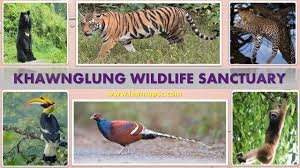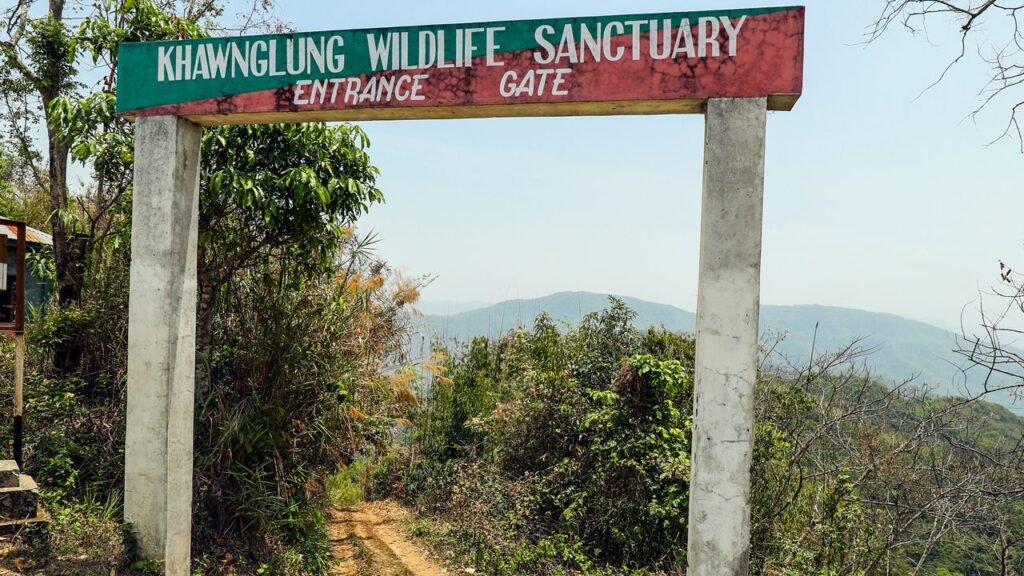Nestled in Mizoram’s verdant hills, Khawnglung Wildlife Sanctuary is not just a haven for biodiversity, it’s also a tapestry of rich history, local culture, and spellbinding natural beauty, making it one of Northeast India’s prime eco-tourism destinations.
Khawnglung Wildlife Sanctuary, located in the scenic Lunglei district of Mizoram, India, sprawls across nearly 35.75 square kilometers and boasts a thriving ecosystem. More than just a protected area, this sanctuary is imbued with folklore, colonial-era tales, and deep cultural resonance for the Mizo people.
Location & How to Reach
Khawnglung Wildlife Sanctuary sits in southern Mizoram near Pangzawl, about 160-170 kilometers from Aizawl, the state capital. The sanctuary’s terrain forms natural fortifications with steep cliffs and dense forests at elevations ranging from 400 to 1300 metres. The nearest town is Hnahthial (about 20 km away), providing amenities and road connectivity.
- By Road: Well-connected by road from Aizawl. Reach Pangzawl and trek ~10 km to the sanctuary gates.
- Nearest Airport: Lengpui Airport, Aizawl (approx. 170 km).
- Nearest Railway Station: Silchar (Assam).
Best Time to Visit: October–March for cooler weather and wildlife sightings. Trekking is necessary to access inner parts of the sanctuary.
Key Details:
Historical Significance
Khawnglung is more than a refuge for wildlife, its rugged landscape has witnessed fierce historical events. The mountain was once home to a village that suffered one of the bloodiest massacres during Sailo chieftain feuds in the mid-19th century.
A local legend from this era is the tragic romance of Chalkunga and Thanghniangi, which endures in Mizo folklore. Thanghniangi was captured during raids but was heroically rescued by Chalkunga, only to be lost to the flooding Tiau River. These tales and songs woven around Khawnglung reflect the cultural resilience of the Mizo people.
Cultural Heritage
Khawnglung epitomizes the intricate relationship between the Mizo people and their environment. Stories, ballads, and oral traditions associated with the sanctuary capture not only the history but also social structures and indigenous knowledge.
Surrounding villages such as Pangzawl, Rawpui, Bungtlang, Sialsir, Lungchhuan, and Chawntui continue to invigorate the culture of the place, welcoming visitors and keeping Mizo hospitality alive.
The local Mizo architecture, with its “Thuruk Vanmawi Memorial Hall” and vibrant color schemes, further add to the visual and cultural richness of the sanctuary.
Sanctuary Flora & Fauna
Ecological Highlights
Khawnglung Wildlife Sanctuary’s sub-tropical and semi-evergreen forests are home to endemic and endangered species. The area receives 2100–2500 mm annual rainfall, which supports lush vegetation and a tranquil atmosphere.
Wildlife
- Mammals: Leopard, sambar deer, barking deer, wild boar, hoolock gibbon, Himalayan serow, slow loris, binturong, and the rare clouded leopard.
- Primates: Especially renowned for its population of hoolock gibbons, the only apes in India.
- Birds: Paradise flycatchers, kingfishers, hornbills, and other vibrant avifauna attract birdwatchers year-round.
- Plants: Dense forests with a mix of bamboo groves and broad-leaved species dominate the landscape.
Khawnglung is a crucial habitat for species conservation and biodiversity research.
Tourist Attractions Within and Nearby
Must-Do Activities:
- Trekking: Rugged gradients and forest trails reward trekkers with sweeping valley views.
- Birdwatching: Rich birdlife throughout the year.
- Wildlife Safari: Organized jungle safaris for glimpses of elusive mammals and birds.
- Cave Exploration: Khawnglung Cave, famous for dramatic rock formations.
- Cultural Tours: Interact with local tribal communities, participate in festivals, and gain insights into Mizo traditions.
Scenic Spots & Nearby Attractions:

Revenue and Economic Impact
While sanctuary-specific revenue data is scarce, Mizoram’s tourism sector has seen sustained growth due to natural attractions like Khawnglung Wildlife Sanctuary.
State-level tourism revenue and foreign exchange earnings have risen consistently over the past decade, with nature-based tourism being a significant driver.
Community-based and eco-tourism initiatives around the sanctuary have also increased, bringing income and sustainable livelihoods to local villages.
Conservation, Management, and Access
Sanctuary Management:
The Department of Environment and Forests, Mizoram, manages Khawnglung with on-ground support from nearby villages. Trekking permits and organized tours help regulate eco-tourism and protect sensitive habitats.
Access Tips:
- Plan travel during the dry season (October–March).
- Carry essentials, as trekking involves remote and steep regions.
- Follow forest department guidelines for responsible tourism.
- Prior booking and permits may be required for trekking or wildlife tours.
FAQs About Khawnglung Wildlife Sanctuary
What is Khawnglung Wildlife Sanctuary famous for?
Khawnglung Wildlife Sanctuary is best known for its rich biodiversity, especially its primate population, rare mammal sightings, birds, and sub-tropical forests. It is also steeped in history and legend, making it a unique eco-cultural destination.
How do you reach Khawnglung Wildlife Sanctuary?
Most visitors travel by road from Aizawl (~160–170 km). The nearest town is Hnahthial. A trek of about 10 km is needed to access the sanctuary.
What animals live in Khawnglung Wildlife Sanctuary?
Common animals include leopards, clouded leopards, sambar and barking deer, wild boar, hoolock gibbons, slow lorises, Himalayan serow, and numerous bird species.
Which is the best time to visit?
October to March is the ideal season, offering pleasant weather and high chances of wildlife sightings.
Is there any cultural or historical significance to Khawnglung?
Yes, Khawnglung is deeply woven into the region’s history, hosting ancient feuds between Mizo chieftains, and is centered on legendary local tales like that of Chalkunga and Thanghniangi.
What activities can tourists pursue?
Popular activities include trekking, wildlife safaris, birdwatching, cave exploration, and cultural immersion with nearby Mizo villages.
Is accommodation available near the sanctuary?
The nearest town Hnahthial offers basic accommodation, while Aizawl provides more options. Home-stay arrangements and guided tours with local communities are increasingly accessible.
